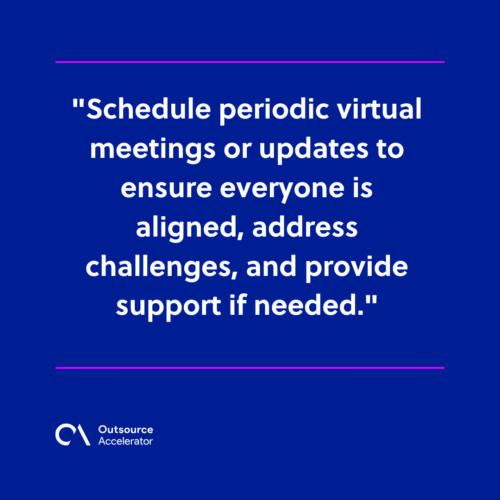Asynchronous work: Definition, pros, and cons

The traditional 9-to-5 office setup gradually gives way to a more flexible and efficient working method. One such approach that has gained significant popularity is asynchronous work.
Some remote teams are still fond of constant meetings and chats among members, further affecting their productivity. Worse, this can lead to meeting fatigue and burnout.
Asynchronous work gives teams the freedom to do their work better while maintaining communication efficiently.
Delve into the concept of asynchronous work, its benefits, drawbacks, and tips for effectively managing asynchronous teams in this article.
What is asynchronous work?
Asynchronous work refers to a work style where team members are not required to be present or available simultaneously for communication.
Asynchronous work allows individuals to work at their own pace and on their own schedule. It helps them focus deeply on tasks without constant interruptions or the pressure of immediate responses.

Asynchronous work vs. Synchronous work
Synchronous work involves real-time interactions where team members engage simultaneously. It utilizes video conferences and instant messaging to stay updated in real-time.
On the other hand, asynchronous work allows for independent work without requiring immediate or simultaneous responses. It relies instead on shared documents, project management tools, and emails for updates and collaboration.
Pros of asynchronous work
Asynchronous work offers several advantages that enhance productivity and collaboration in a remote environment.
Better documentation
Documentation maintains clarity and transparency within in-house or remote teams.
Since real-time discussions and meetings are not always possible, team members rely heavily on email and other written communication.
Better project documentation results in a comprehensive recording of ideas, decisions, and project updates, which can be referred to later. This also promotes accountability and reduces the likelihood of miscommunication.
Deeper focus at work
Studies using Microsoft Teams data find that work-related multitasking happens in 30% of virtual meetings. This can affect productivity by getting teams constantly distracted and overwhelmed with information anywhere.
Asynchronous work provides an environment conducive to deep work and increased focus.
Without the constant interruptions of virtual meetings, individuals can leverage uninterrupted periods to produce high-quality work. This deep focus allows for enhanced creativity, problem-solving, and innovation.
Thriving diverse work personalities
Asynchronous work accommodates different work styles and personalities, making it an ideal setup for diverse teams.
Not everyone operates optimally during standard working hours, and asynchronous work enables individuals to customize their schedules to align with their peak productivity hours.
It allows team members to work when they are most engaged and motivated.

Cons of asynchronous work
While asynchronous work brings numerous advantages, it is important to recognize and address its potential drawbacks.
Lack of organizational connection
One of the downsides of asynchronous work is the potential loss of a sense of organizational connection.
Team members may feel disconnected from the company’s culture and values without regular face-to-face interactions. Building strong team relationships and fostering a cohesive work environment can be more challenging in an asynchronous setup.
Employing additional strategies such as virtual team-building activities and regular check-ins can help mitigate this potential issue.
Tendencies of micromanagement
In an asynchronous work setting, there is a risk of micromanagement stemming from a lack of trust or visibility. Managers may feel compelled to constantly monitor their team’s progress and activities, decreasing autonomy and productivity.
To prevent this, managers must cultivate a culture of trust and provide clear objectives and expectations. This allows team members the freedom to take ownership of their tasks.
Work and life boundaries blurring
Boundaries between work and personal life might be blurred with asynchronous work.
Without clearly defined working hours or physical separation between home and office, individuals may find it challenging to disconnect from work.
Striking a balance between work responsibilities and personal well-being becomes paramount in an asynchronous work environment.
Establishing routines, setting boundaries, and practicing self-discipline are essential to managing this potential challenge.
Asynchronous work management tips and best practices
To ensure the success of asynchronous work, it is crucial to implement effective management strategies.
Here are some tips and best practices for managing asynchronous teams:
Set expectations and deadlines. Clearly define each task or project’s objectives, expectations, and deadlines. Providing clarity on deliverables and timelines helps team members plan their work and ensures everyone is on the same page.
Foster a culture of trust
Trust is a cornerstone of successful asynchronous work. Managers should demonstrate trust in their team’s abilities and allow for flexibility and autonomy.
Encourage knowledge sharing
Despite working asynchronously, it is essential to encourage collaboration among team members. Facilitate opportunities for virtual brainstorming sessions, knowledge sharing, and peer support.
Maintain regular check-ins
Regular check-ins and status updates are crucial in an asynchronous work environment.
Schedule periodic virtual meetings or updates to ensure everyone is aligned, address challenges, and provide support if needed.

Asynchronous work offers numerous benefits, including better documentation, increased focus, and accommodating diverse work personalities.
By implementing effective management strategies, teams can successfully navigate asynchronous work environments and reap many rewards.







 Independent
Independent




